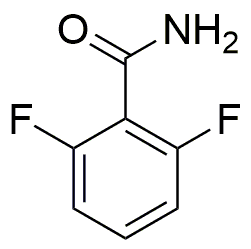2,6-Difluorobenzamide is widely utilized in research focused on:
- Pharmaceutical Development: This compound serves as a key intermediate in the synthesis of various pharmaceuticals, particularly in the development of drugs targeting neurological disorders.
- Agricultural Chemicals: It is used in formulating agrochemicals, contributing to the design of effective herbicides and pesticides that help improve crop yields.
- Material Science: The compound is explored for its potential in creating advanced materials, particularly in polymers that require specific thermal and mechanical properties.
- Biochemical Research: Researchers utilize it to study enzyme interactions and metabolic pathways, providing insights into biological processes that can lead to new therapeutic strategies.
- Fluorinated Compounds Research: Its unique fluorine atoms make it valuable in the study of fluorinated compounds, which often exhibit enhanced stability and bioactivity compared to their non-fluorinated counterparts.
General Information
Properties
Safety and Regulations
Applications
2,6-Difluorobenzamide is widely utilized in research focused on:
- Pharmaceutical Development: This compound serves as a key intermediate in the synthesis of various pharmaceuticals, particularly in the development of drugs targeting neurological disorders.
- Agricultural Chemicals: It is used in formulating agrochemicals, contributing to the design of effective herbicides and pesticides that help improve crop yields.
- Material Science: The compound is explored for its potential in creating advanced materials, particularly in polymers that require specific thermal and mechanical properties.
- Biochemical Research: Researchers utilize it to study enzyme interactions and metabolic pathways, providing insights into biological processes that can lead to new therapeutic strategies.
- Fluorinated Compounds Research: Its unique fluorine atoms make it valuable in the study of fluorinated compounds, which often exhibit enhanced stability and bioactivity compared to their non-fluorinated counterparts.
Documents
Safety Data Sheets (SDS)
The SDS provides comprehensive safety information on handling, storage, and disposal of the product.
Product Specification (PS)
The PS provides a comprehensive breakdown of the product’s properties, including chemical composition, physical state, purity, and storage requirements. It also details acceptable quality ranges and the product's intended applications.
Certificates of Analysis (COA)
Search for Certificates of Analysis (COA) by entering the products Lot Number. Lot and Batch Numbers can be found on a product’s label following the words ‘Lot’ or ‘Batch’.
Número de catálogo
Número de lote/lote
Certificates Of Origin (COO)
This COO confirms the country where the product was manufactured, and also details the materials and components used in it and whether it is derived from natural, synthetic, or other specific sources. This certificate may be required for customs, trade, and regulatory compliance.
Número de catálogo
Número de lote/lote
Safety Data Sheets (SDS)
The SDS provides comprehensive safety information on handling, storage, and disposal of the product.
DownloadProduct Specification (PS)
The PS provides a comprehensive breakdown of the product’s properties, including chemical composition, physical state, purity, and storage requirements. It also details acceptable quality ranges and the product's intended applications.
DownloadCertificates of Analysis (COA)
Search for Certificates of Analysis (COA) by entering the products Lot Number. Lot and Batch Numbers can be found on a product’s label following the words ‘Lot’ or ‘Batch’.
Número de catálogo
Número de lote/lote
Certificates Of Origin (COO)
This COO confirms the country where the product was manufactured, and also details the materials and components used in it and whether it is derived from natural, synthetic, or other specific sources. This certificate may be required for customs, trade, and regulatory compliance.


